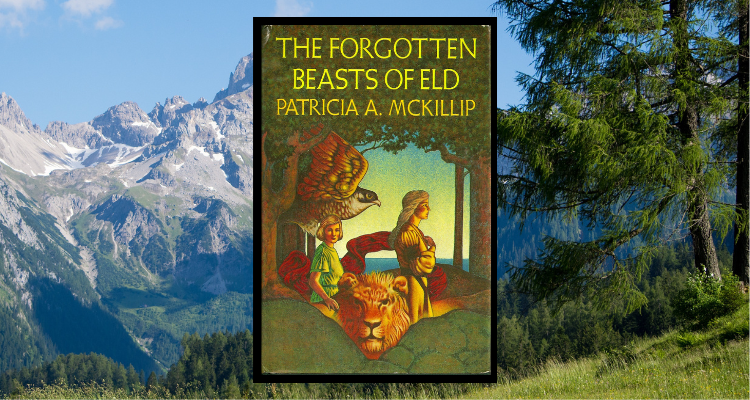|
American writer Patricia A. McKillip, who died in May 2022, was a major author of fantasy and science fiction. She was noted for her stylised, poetic prose and for stories rich with strong themes. She wrote many novels including the Riddle-Master trilogy (1976 - 1979), but all of her books after 1994 were standalones.
McKillip’s breakthrough was her first novel for adults. The Forgotten Beasts of Eld was published in 1974, and won the first World Fantasy Award the following year. The book was written when the author was just 26, and has become a prominent classic of the genre. Notably, it is an entry in both iterations of the Fantasy Masterworks line. The book focuses on a powerful “wizard woman”, who dwells in seclusion with a group of enchanted animals held there by her magic. But how does the novel weave a spell of its own?
The Forgotten Beasts of Eld can be thought of as a book of two halves. The first half is set entirely on Eld Mountain, where the young and beautiful wizard woman Sybel lives in a kind of splendid isolation. The second half completes Sybel’s exposure to a wider fantasy setting, which complicates her life with love, revenge, and war. To a large extent, the book is about power. It is about what it means to have power, how best to use it, and whether to keep it or to relinquish it. In keeping with McKillip’s other work, magic here is often a quiet and subtle thing. Sybel and other wizards deal not in fire and lightning, but in twists of will that can change lives and alter the fate of nations.
When the story begins, Sybel is almost completely cut off from the world and knows little about it. Her father has died, and her only human contact is the old witch Maelga. Sybel shares a house with a loose group of magical animals, with whom she can speak telepathically. There is a giant black swan, the fearsome cat Moriah, the faithful lion Gules, the ageing dragon Gyld, and the dependable falcon Ter. Lastly there is Cyrin, a wise boar who deals in riddles and, uniquely among the animals, can speak aloud. Content with these creatures, Sybel needs nothing from the world. The world, however, has other ideas. When Sybel is 16, she is given a baby to care for. The boy, Tamlorn, grows up with her on Eld Mountain and becomes the centre of her life. His presence there, and his parentage, gradually draws Sybel and her animals into the cares and conflicts of the human world. She is caught between the nations of Mondor and Sirle, two rival states adjacent to the mountain who have been at war before and may be so again. Both regimes covet not only young Tam, but also Sybel’s power to control her animals - and even the minds of people. McKillip handles this plot with more subtlety than many authors would. There are no battles in the novel, and little in the way of overt violence or physical action. In this respect, the book has a similar feel to the Earthsea novels by Ursula K. Le Guin, which also deal with power as a central theme. At times, the book does summon up a different kind of tension. A sequence in which Sybel finds herself at the mercy of a cruel and domineering male wizard is memorable for its sense of menace and despair. One real strength of the book is the development of Sybel’s character. She genuinely changes over the course of the narrative, altered by her broadening experience with the outside world. McKillip’s implication that a person who lives in isolation would be essentially emotionless and the suddenness of some of Sybel’s changes can be jarring, but the protagonist thinks and feels very differently by the end of the story. This is welcome in a genre in which characters are often static paragons of good or evil; and Sybel is by no means an entirely good or consistently likeable heroine. Compared with the later Riddle-Master trilogy, The Forgotten Beasts of Eld has some other strengths. It is far easier to read, and McKillip’s style here is clear and concise. As Pat Cadigan observes in her introduction to the Fantasy Masterworks edition of the novel, later authors might take multiple volumes to tell this same story. There are also some welcome flashes of humour in the story, something which is almost completely absent in the confusing and overly serious Riddle-Master trilogy, which draws as much from the ponderousness of Tolkien as it does from Le Guin. While it offers little in the way of excitement, The Forgotten Beasts of Eld is a thoughtful and imaginative fantasy novel which is a welcome contrast with the often bloated, sluggish entries in the genre today. It is also a good entry point into the extensive work of the late Patricia A. McKillip.
2 Comments
9/18/2022 03:41:23 pm
I recently reviewed her YA (ish) novel Moon-Flash (1984): https://sciencefictionruminations.com/2022/06/14/book-review-moon-flash-patricia-a-mckillip-1984/
Reply
9/18/2022 07:57:51 pm
Initially I read the Riddle-Master trilogy and wasn't at all fond of it. Didn't think I'd read another of hers but was very glad I read this one - I vastly prefer it. Haven't read any of her SF, as yet.
Reply
Your comment will be posted after it is approved.
Leave a Reply. |
About
Exploring classic science fiction, with a focus on the 1950s to the 1990s. Also contributing to Entertainium, where I regularly review new games. Categories
All
|

